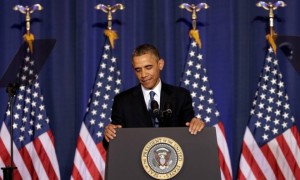 On May 23, 2013, American president, Barack Obama, delivered a signal speech on the American “War on Terror.” Recognizing the ambiguity that this war has always possessed, Obama admitted early on in his speech: “America is at a crossroads. We must define the nature and scope of this struggle, or else it will define us. We have to be mindful of James Madison’s warning that no nation could preserve its freedom in the midst of continual warfare. Neither I nor any president can promise the total defeat of terror.” With that said, the president spent the next several minutes detailing threats posed to the nation and its people for over three decades in the context of the decline of the Cold war, the rise of new technology, and the general animosity particular groups/movements have toward the United States.
On May 23, 2013, American president, Barack Obama, delivered a signal speech on the American “War on Terror.” Recognizing the ambiguity that this war has always possessed, Obama admitted early on in his speech: “America is at a crossroads. We must define the nature and scope of this struggle, or else it will define us. We have to be mindful of James Madison’s warning that no nation could preserve its freedom in the midst of continual warfare. Neither I nor any president can promise the total defeat of terror.” With that said, the president spent the next several minutes detailing threats posed to the nation and its people for over three decades in the context of the decline of the Cold war, the rise of new technology, and the general animosity particular groups/movements have toward the United States.
Much of the action the U.S. has taken during the period since 9/11 has fallen under an act passed by Congress on September 14, 2001 called the Authorization to Use Military Force. While not a formal declaration of war, the act clearly produced a culture of war, as Obama acknowledged: “I look forward to engaging Congress and the American people in efforts to refine and ultimately repeal the AUMF’s mandate,” he said. “And I will not sign laws designed to expand this mandate further. Our systematic effort to dismantle terrorist organizations must continue. But this war, like all wars, must end. That’s what history advises. It’s what our democracy demands.”
So what will it look like when “this war” ends? Will it take the closing of the prison camp at Guantanamo Bay? Or the removal of all troops from Afghanistan? Did it end in the raid that killed Osama bin Laden? Or will the use of drones prolong it indefinitely?
I have been somewhat fascinated by iconic images related to the end of wars for what they reveal and conceal about the efforts they depict. Considering images from other American wars, I am curious how readers see images emerging from this one.
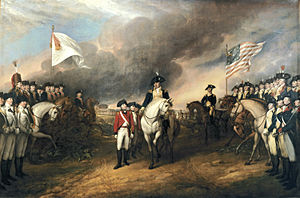 John Trumbull’s painting Lord Cornwallis surrendering at Yorktown in 1781: the heroic almost pastoral representation of a moment that became significant as a founding myth.
John Trumbull’s painting Lord Cornwallis surrendering at Yorktown in 1781: the heroic almost pastoral representation of a moment that became significant as a founding myth.
Appomattox Court house in 1865, surrounded by Federal soldiers. The complete lack of death and destruction betrays the battles that raged for most of the war and, especially, the two that came at the very end of it. And it appears that the photo does not contain a single black American.
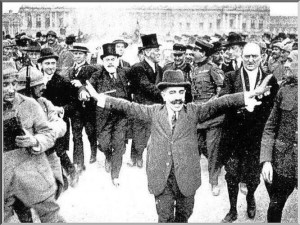 A photo taken soon after the Treaty of Versailles was signed. Perhaps fittingly, American president Woodrow Wilson appears quite happy–like the peace itself, such joy was decidedly short lived.
A photo taken soon after the Treaty of Versailles was signed. Perhaps fittingly, American president Woodrow Wilson appears quite happy–like the peace itself, such joy was decidedly short lived.
Undoubtedly iconic, this photo associated with V-J Day is also creepy. The “joyous” embrace of a nurse by a sailor is also quite apparently in conflict with the aggressiveness of the act itself. Was it a sign of things to come–the imposition of gender roles through behavior in part sanctioned by official America? It also contains eery echoes of the recent disclosure of disgraceful and violent behavior by military men against their female counterparts.
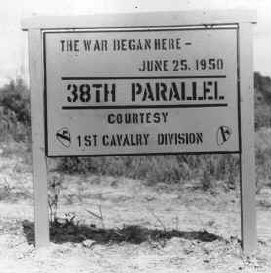 The simplicity of this sign betrays the ambivalence and complexity of the American relationship to the Korean War. If Obama wonders when we can declare an end to the War on Terror, I imagine millions of Koreans (and many thousands of Americans) continue to seek an end to the conflict on the Korean peninsula.
The simplicity of this sign betrays the ambivalence and complexity of the American relationship to the Korean War. If Obama wonders when we can declare an end to the War on Terror, I imagine millions of Koreans (and many thousands of Americans) continue to seek an end to the conflict on the Korean peninsula.
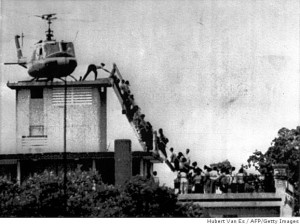 This photo continues to fascinate my students. Unlike most other iconic images of a war’s end, this one has what looks like people physically running to exit the war itself. The contested meaning of the Vietnam War inhabits the helicopter (an iconic transport) balancing precariously atop a small foreign structure while an American seems poised to both help and resist the faceless crowd of people seeking escape.
This photo continues to fascinate my students. Unlike most other iconic images of a war’s end, this one has what looks like people physically running to exit the war itself. The contested meaning of the Vietnam War inhabits the helicopter (an iconic transport) balancing precariously atop a small foreign structure while an American seems poised to both help and resist the faceless crowd of people seeking escape.
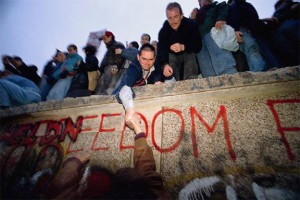 Among the most deceptive photos to end any war, this photo of the days surrounding the “fall” of the Berlin Wall, seemed to be the purest expression of a “good” end to a war we would likely ever get. And then the Balkans exploded.
Among the most deceptive photos to end any war, this photo of the days surrounding the “fall” of the Berlin Wall, seemed to be the purest expression of a “good” end to a war we would likely ever get. And then the Balkans exploded.
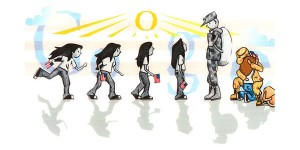 Perhaps not coincidentally, President Obama’s address on how to end or wind down or transform the War on Terror coincided with Google announcing the winner of its doodle competition for 2013. This year Sabrina Brady, a high school student from Sparta, Wisconsin, won with an entry fitting (perhaps “all together fitting”) Memorial Day tributes. According to press coverage, Brady’s entry depicted the return home of her father after an 18-month deployment in Iraq. The scene is touching and the action nicely rendered but the drawing also suggests the localization of the moment–a single soldier returning home to his daughter. This war has, it seems to me, been comprised of local stories–the personal tribulations of soldiers and military personnel barely registers at a national level. Certainly their trials don’t seem ready for mythical reworking which took place with other wars in which collective sacrifice–even if for unpopular, ambivalent, and conflicted wars–had credence.
Perhaps not coincidentally, President Obama’s address on how to end or wind down or transform the War on Terror coincided with Google announcing the winner of its doodle competition for 2013. This year Sabrina Brady, a high school student from Sparta, Wisconsin, won with an entry fitting (perhaps “all together fitting”) Memorial Day tributes. According to press coverage, Brady’s entry depicted the return home of her father after an 18-month deployment in Iraq. The scene is touching and the action nicely rendered but the drawing also suggests the localization of the moment–a single soldier returning home to his daughter. This war has, it seems to me, been comprised of local stories–the personal tribulations of soldiers and military personnel barely registers at a national level. Certainly their trials don’t seem ready for mythical reworking which took place with other wars in which collective sacrifice–even if for unpopular, ambivalent, and conflicted wars–had credence.

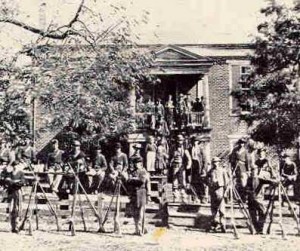
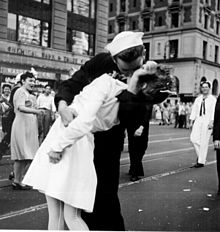
12 Thoughts on this Post
S-USIH Comment Policy
We ask that those who participate in the discussions generated in the Comments section do so with the same decorum as they would in any other academic setting or context. Since the USIH bloggers write under our real names, we would prefer that our commenters also identify themselves by their real name. As our primary goal is to stimulate and engage in fruitful and productive discussion, ad hominem attacks (personal or professional), unnecessary insults, and/or mean-spiritedness have no place in the USIH Blog’s Comments section. Therefore, we reserve the right to remove any comments that contain any of the above and/or are not intended to further the discussion of the topic of the post. We welcome suggestions for corrections to any of our posts. As the official blog of the Society of US Intellectual History, we hope to foster a diverse community of scholars and readers who engage with one another in discussions of US intellectual history, broadly understood.
The entry from Sabrina Brady also represents, to me, the focus since the late 1990s on “the soldiers” (wearing desert fatigues) as the unifying entity. I like it.
For me, however, I probably would’ve chosen this picture (embedded on a book cover). I like the contrasts—with the burning oil well/rig in the background.
Was there an enduring image of Desert Storm? It seems to me that the era of the end of war image is over owing to the death of the draft and transition from wars of engagement to wars of occupation. I think the most enduring image of finality to the War on Terror will be Bush’s premature “Mission Accomplished” photo-op on the aircraft carrier in 2003.
Fascinating post. I wonder if, whenever the War on Terror “ends”, there won’t be an image that sums it all up? It may just gradually fade away from the news and into memory.
Or, more likely, the image that sums up the end of the war will be something personal, something like a soldier coming home and embracing his or her family (like in the Google Doodle). Not quite the retreat seen at the end of Vietnam, but not quite the triumphal imagery of WWII or the War of Independence either.
And interesting that we don’t have an image from the end of the First Gulf War. Perhaps that’s due to our continued engagement in conflicts in the Greater Middle East, or the fact that at the time, the victory in the war was immediately overshadowed by domestic economic concerns.
I suspect the “War on Terror” will be represented like WWII as a “justified war” with the twin towers symbolizing the unprovoked attack as Pearl Harbor has epitomized for so long. Attempting to complicate the image with historical context will be rejected as sympathy for the “aggressor”.
A thought: all of the images show ends to conflicts in which there were either clear victors and vanquished, or else stalemates and agreements to cease fighting. But can one side simply declare a war over if the other side keeps fighting? In other words, even if Obama *declares* an end to the “war on terror,” if AQ and other radical Islamists, e.g. Taliban, keep fighting is the war really over? I’ve been thinking about this particularly with regard to leaving Afghanistan. If the Taliban comes back into power, how is an “end to the war” different from a “defeat”?
if AQ and other radical Islamists, e.g. Taliban, keep fighting is the war really over?
Bill nails the problem.
When Bonaparte is defeated, Bonapartism dies. Hitler’s death ends Nazism. Even Communism, with its manifest incompatibility with actual human society, is [we hope] on the ash heap of history with only the Castros and il-Sungs to be mopped up.
But there’s a danger in the one-size-fits-all approach to political force and ideology– Islamism is precisely where. It’s the world’s most enduring politics [1400+ years and counting] and has the added dimension of divine sanction among its adherents, far more powerful than a Marxism/humanism.
Neo-conservatism was not facially absurd–the political proposition that all men yearn to breathe free if accorded the choice. Yes, it has run into the problem of the “order” part of “ordered liberty”–the ex-Soviets still prefer the authoritarianism of Putin to the near-anarchy of bourgeois liberalism, as do China and Singapore and a host of other functional states. Freedom is useless with the barbarians overrunning your gates.
And neo-conservatism was put to the test in the one place that rejects its central proposition–the Muslim world. Indeed, freedom can be said to have won in Iraq as much as is possible in such a tribal and religious milieu. At the moment, y’d rather be there than Syria. [Tho that may not be true next year.]
Unfortunately, Islamism is not going the way of Bonapartism or Nazism or even Communism, which are all creatures of this world, not the next. One size does not fit all, not all ideologies can be thrown into an undifferentiated soup marked “politics” or “religion.” Bonaparte and Hitler, OK. Islam, not so much.
Neoconservatism of the impose-freedom-with-a-gun variety (e.g. Iraq 2003) proved criminally stupid, as many had foreseen (tho unfortunately they were not in the Bush admin).
To say that “the Muslim world” “rejects” “freedom” is a bizarrely pointless remark, lumping together as it does billions of diverse people under one umbrella (“the Muslim world”) and attributing to all of them the same views. (Btw, have you heard of the Arab Spring?)
Two short points:
1. Re the “war on terror” phrase: unless I’m mistaken, the Obama admin officially abandoned this phrase well before the Pres’s recent speech. I don’t think the phrase itself appears in the recent speech, though I wd have to look at the transcript again to be sure.
2. The image on the cover of Hobsbawm’s ‘Age of Extremes’, linked by T. Lacy above, is an image from the Gulf War (Desert Storm), though it did not become an ‘iconic’ one.
Nice piece, Ray, but some quibbles [read “fundamental disagreements”]:
A photo taken soon after the Treaty of Versailles was signed. Perhaps fittingly, American president Woodrow Wilson appears quite happy–like the peace itself, such joy was decidedly short lived.
It was an “armistice”*, a cessation of hostilities, not exactly a peace–it was more a halftime betw WW’s One and Two. A peace is when the Romans conquer your ass, enslave some of you and commission the rest in their army.
Or the Pax Americana, which flattened the Axis and then at great expense to itself dusted them off and helped them back to their feet as independent equals.
“I look forward to engaging Congress and the American people in efforts to refine and ultimately repeal the AUMF’s mandate,” he said. “And I will not sign laws designed to expand this mandate further.”
Oh, I think he will. Soon I think you’ll see the AUMF updated, re-authorized, clarified and likely expanded to accommodate the growing asymmetricality of this war. As Blind Sheikh prosecutor [1993] Andrew McCarthy noted the other day, the scorecard is Bush: 3 al-Q dudes waterboarded, Obama: 4 American citizens blown up by drones. President Obama may not approve of his own actions, but Congress does. ;-}
Undoubtedly iconic, this photo associated with V-J Day is also creepy. The “joyous” embrace of a nurse by a sailor is also quite apparently in conflict with the aggressiveness of the act itself.
Ray, I’d love to poll this one with actual women, even in 2013. Kiss a sailor who helped bring down Tojo? Well, of course y’d have to explain who Tojo was. [He was like bin Laden except he tortured, raped and killed millions of people.]
This photo continues to fascinate my students. Unlike most other iconic images of a war’s end, this one has what looks like people physically running to exit the war itself.
Ray, you next speak of one of the “the most deceptive photos to end any war.” It’s unclear from your post here that that famous photo of helicopters fleeing the American embassy’s roof in Vietnam is actually from 1975—2 years after Nixon had pulled the last combat troops from South Vietnam, but only days after Congress pulled all funding from the S. Viet government.
“It became the most remembered photograph of the fall of Saigon, capturing the last chaotic days of the Vietnam war, and most people believed that it showed desperate Americans crowding on to the roof of the United States Embassy to board a helicopter. That is what the picture caption usually says.
PHOTO: Hubert Van Es / United Press International
The roof of 22 Gia Long Street, not the U.S. Embassy.
But as with much about the Vietnam war, the caption is wrong. The building is an apartment complex. The people fleeing are Vietnamese. The last helicopter left about 12 hours later.
In its way, the photograph is a metaphor for all the misunderstanding that plagued the Vietnam war. Americans, whether conservative or liberal, often imposed their own ideas on that troubling war, and that seems to be what happened with the picture, said Hubert Van Es, a United Press International photographer who took it 25 years ago, on April 29, 1975, from the roof of a hotel half a mile away.”
____________
I’m a little historically nonplussed at many comments here today @ USIH-blog, which bears “history” in its title. Today is Memorial Day, to honor all those who died in American uniforms–not Veterans’ Day, which honors all those who served in the military. Further, Veterans’ Day was once known as Armistice Day, commemorating those who served in the most disastrous, vainglorious and useless war ever fought by man.
[The First World War, which killed 10+ million, to no end, for no good reason, for absolutely nothing of value or worth.]
________
*”This year Sabrina Brady, a high school student from Sparta, Wisconsin, won with an entry fitting (perhaps “all together fitting”) Memorial Day tributes. According to press coverage, Brady’s entry depicted the return home of her father after an 18-month deployment in Iraq.”
Of course I appreciate the sentiment, but these heroes are not who Memorial Day is dedicated to.
But the lines betw Memorial Day and Veterans Day have become somewhat blurred in terms of how they are observed.
Speaking of historical accuracy, there are several things to take issue w in T Van Dyke’s remarks. First, I think the ‘fall’ of Saigon did not occur “days” after Congress cut off funding, unless by days you mean months; not a major thing, perhaps. Second, the First World War was certainly disastrous and devoid of much point, but so have been some (quite a few) other wars, and I’m not sure much is served by singling out one war as the *most* useless ever fought. Third, the Andrew McCarthy remark is silly; it ignores significant differences in the Bush and Obama approaches. Well, that’s enough for one comment.
Tom: Pakistan just had the first transition via elections from one civilian govt to another in its history. Worth noting in view of yr remarks about ‘the Muslim world’.
Not really my point about the Muslim world. First, democracy is not inherently good, and an Islamic democracy can be not palpably different than a monarchy. Further, I’m not really dissing Islamic governments, just saying that Muslims might favor a holy nation over a free one.
As for the Fall of Saigon, you’re correct, it was months, not days. The overall point holds, that the famous evacuation photo is not what most people believe it to be.
And of course the Andrew McCarthy remark is “silly.” But it is accurate. ;-P
Cheers.